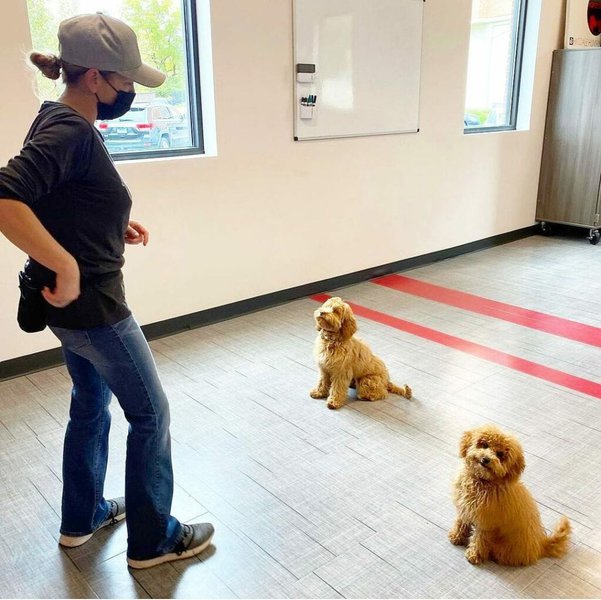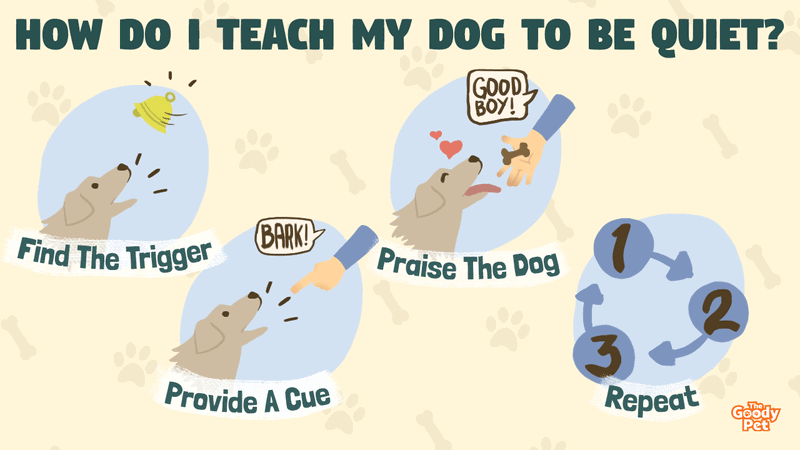As a dog owner, you have most likely struggled with stopping your dog from barking. One of the most effective ways to stop your dog from barking is using the “Quiet” command. But sometimes, your dog might not stop barking even if you yell, “Quiet!” It shouldn’t have to go this way. You need to train your dog to understand the “Quiet” command. I did extensive research on how to teach your dog to be quiet, and here is what I found. So, what is the “Quiet” command?
With consistency and dedication, teaching your dog the “Speak” and “Quiet” commands gives you control over your dog’s barking tendencies whenever the need arises. Teaching dogs these commands can be fun and rewarding in warding off intruders promptly and improving the dog’s natural instincts.
Fortunately, you can efficiently train your dog not to bark or speak or command with a proper guide. All you need to know is what triggers their barking, and then you can start the training sessions. There are a good number of methods and techniques you can use depending on the dog’s barking trigger. In this post, you’ll learn how to teach your dog to be quiet or stop barking so that you can always gently ask the dog to stop barking. So, keep reading to find out simple methods for this training.
How Do I Get My Dog To Be Quiet?
There are a number of techniques that can be used to help prevent your dog from barking, including ignoring the barking, removing the motivation, desensitizing the dog’s stimulus, etc. While all these methods can be successful, you should never expect results overnight.
The longer the dog has engaged in barking behavior, the longer the time needed for them to develop another means of communication. One of the most effective methods to get your dog to be quiet is using the “quiet” command. Training your dog to understand the quiet command is made easy with this guide.
Before You Start Training

Prior to the training, it is essential to understand why your dog is barking in the first place. Barking is a natural way dogs use to communicate, and it is also a way dogs use to release tension, stress, and anxiety.
Some dogs may bark out of fear and anxiety, while others will bark from excitement. It is always a great idea to work on the emotions, preferably with the help of a behaviorist, rewards-based trainer, or your vet.
The main goal is to change how the dog feels, and once you manage to do that, then the barking tendencies will start to fade away naturally.
Additionally, it is crucial not to yell at the dog to shut up, especially when the dog doesn’t understand. This will only make your dog feel like you’re joining in the commotion.
Therefore, anytime you’re teaching your dog to speak or “Quiet” commands, it is essential to stay calm. The best way to go about this is first to train your dog to speak, then teach your dog how to be quiet.
How Do I Train My Dog to Speak On Command?
Believe it or not, the best way to teach your dog to be quiet on command is to train them to bark on command. Teaching your dog how to speak is relatively easy compared to teaching a dog how to be quiet.
Here are some simple steps you should follow;
Find Something That Makes The Dog Bark/Barking Trigger
Before you begin teaching your dog how to bark, you will require something that will offset its barking. This could be, for example, opening a recording of other dog sounds, a siren, or any other noise.
However, sometimes the dog may be smart enough to realize that it is only a recording and won’t bark. When this happens, you can try barking yourself or locking yourself outside the house and knocking continuously. Once you find the perfect way to make your dog bark, it is now time to proceed to the next step.
Provide A Cue
Say a word like “Bark” or “Speak,” then follow up with the method you have chosen to make the dog bark. For example, if you’re doing a siren, ring, or bark, make the sound right after you give the “Speak” command.
Praise Your Dog For Barking
When the dog barks, appreciate it by saying “thank you” or “yes” and then give it a treat. Most dogs will be surprised whenever they are encouraged to bark rather than stopped or given a bad reaction because of barking.
Repeat
You need to repeat this command as many times as possible until your dog gets the cue. Practice the cue several times daily, however, in short sessions. Do this until your dog learns how to talk; then, you can proceed to teach your dog how to be quiet.
How Do I Teach My Dog To Be Quiet?
To train your dog to be quiet, start with the “Quiet” command and ensure your dog understands it before moving on to the bark command.
While some people might be able to teach both commands at the same time, it is your choice. It is also ultimately based on your confidence, comfort levels, and the ability of the dog to learn.
However, since dogs tend to become excessive barkers quickly, it’s best for them to learn the quiet cue first. For the “Quiet” command, you can choose one simple word that is easy to remember, then use it consistently. Some good examples are “Shush,” “Enough,” or “Hush.”
What You Will Need
Before you get started on the training, there are two main vital things you need;
- Delicious dog treats or your dog’s favorite toy. Since you want to make the actions worth it, your chosen rewards should be very valuable and immediate. For example, small pieces of liver, chicken pieces, etc.
- A barking stimulus, like someone knocking at the door or a doorbell.
To teach the dog the “Quiet” command, here are some steps you should consider;
- Create a situation that makes your dog bark. For example, knock on the door, or have someone ring the bell. Sometimes making your dog feel excited or seeing another dog can cause barking.
- When the dog barks, acknowledge that you heard the barking by looking out of the door or window for its source.
- Go back to the dog and ensure you get its attention by either holding a toy or a treat in your hand.
- The dog will most likely stop barking and when it does, give it a treat or its toy.
- Repeat these above steps several times and gradually increase the period of silence the dog gives before giving the toy or treat.
- When the dog stays quiet several times, then you can add the command word you’ve chosen. To do this, say the command in an audible, firm, and calm tone while your dog is barking. Ensure you’re holding the reward for the dog to see, and once the barking stops, reward your dog.
- Practice the “Quiet” command several times, but keep the training sessions as brief as possible. However, you can always do this anytime your dog barks to ensure it learns the command.
What Not To Do When Teaching Your Dog To Be Quiet
When training your dog to be quiet, there are certain things you shouldn’t do, including;
- Never encourage your dog to bark at different things like nearby dogs, children playing, or people passing by and abruptly getting up fast and looking through the windows or shouting, “Who’s there?”
- Don’t punish the dog for barking at sounds like kids playing in the streets but encourage your dog to bark at sounds like people coming at your door.
- Never use methods of punishment if the dog is barking out of fear or anxiety. This would only make it worse, causing the barking to increase.
- Don’t use a muzzle for long periods to ensure the dog remains quiet or when you’re out and about and not actively supervised. While wearing muzzles, dogs cannot drink, eat, or pant to cool themselves, which means making them wear the muzzles for long periods is inhumane.
- Don’t tie the dog’s muzzle using a cord, rubber band, rope, or anything else. Doing this will only be painful, inhumane, and dangerous.
Do Vets Recommend Bark Collars?
Anti-bark collars, which are devices used to train dogs to be quiet, are not recommended by vets as the first choice when it comes to dealing with a backing problem.
This is especially true for barking motivated by anxiety, compulsion, or fear. Most of these collars give an unpleasant stimulus to the dogs when they bark, and although they may help stop barking, they might hurt the dog.
More Tips for Training Your Dog to Be Quiet
Here are additional tips you should consider for the “Speak” and “Quiet” commands;
- Training the dog to speak will only work for dogs that bark. If you’re planning to train a puppy to speak, you need to wait until the dog develops the ability or desire to bark. Some dogs might not bark but will instead make some sounds.
- Ensure your dog is always on the leash so that you can control its behavior and also control its rewards. If you allow the dog to go towards whatever is causing the barking, then this will only reward the behavior. As a result, being on a leash is important.
- Clicker training works effectively when it comes to “Speak” and “Quiet” commands.
- Practice these commands in different environments outside the house in varying situations, such as in the car, in the park, or during a walk.
- Remember that for certain dog breeds, it might take time before the barking habit gets dropped.
- You may switch between different barking stoppers to work with and see which one works best for your dog.
- Proceed to reward the dog only when the dog responds well to a “Quiet” command. However, if the dog stops responding, you need to go back to doing the previous steps before moving on.
- Note that every dog has a unique barking trigger. One dog may bark less when someone knocks on the door or rings the bell but barks excessively when a loud truck passes nearby. For this reason, you need to pay attention to how your dog reacts to different sounds or triggers and adjust your training sessions to match the specific triggers.






